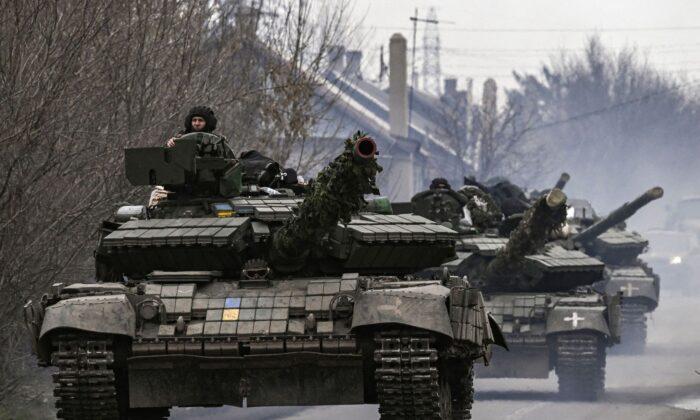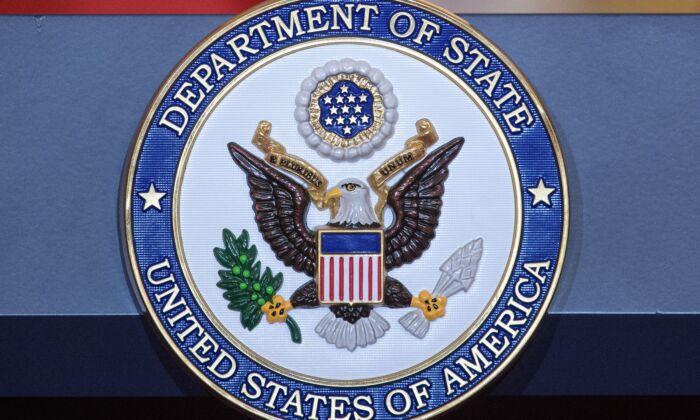Continuous arming of Ukraine could lead to an escalation of the war with Russia that could eventually spiral out of control, expanding outside Ukraine, said an international security expert.
“I actually believe that the more weapons we pour into this, the more Russia is also going to double down,” Mr. Abrahms added.
In 1991, the Soviet Union, which was comprised of 15 republics including Ukraine, ceased to exist as a sovereign state and its constituent republics gained independence.

Mr. Abrahms said that he favors a kind of “off-road” or “off-ramp” solution to resolve the Russia–Ukraine conflict.
The war has the potential to expand into “a hot war” outside Ukraine, Mr. Abrahms said.
It has already inflicted so much harm on Ukrainians, including the civilian population, he said. Russia could harm more civilians if it wanted to, although it is not known “what the threshold is for Putin,” Mr. Abrahms continued.
“The current U.S. strategy is to basically coerce Putin to the negotiating table by providing unlimited assistance to Ukraine, I don’t think that’s going to work.”
The United States is likely banking on “the deterrence model” in its approach to the war in Ukraine, Mr. Abrahms said. “The idea is that if one side, say the Ukrainians, gets strong enough, that this will dissuade Russia from persisting with war.”
But there is also “a spiral model” that should be taken into consideration as “equally important,” Mr. Abrahms said.
“The idea is that the more weapons we supply, including ones which are very controversial, that this could actually reinforce the possibility of escalation on the Russian side, and that things will even get even more out of control, both in Ukraine and wider.”
Mr. Abrahms believes that the leaders of NATO countries, who convened earlier this month at the NATO summit in Lithuania, overwhelmingly support the deterrence model, but “they really do need to take seriously the spiral model as well.”

Possibility of Civilian Victimization
Mr. Abrahms’s concern is that “the West, pouring weapons into Ukraine, is going to drag out this war of attrition, [which] is actually going to make the Russians even more likely to turn their guns directly on the population.”It was found in “methodologically serious research” that the main determinant as to whether a government is more or less likely to use massive force against the population, trying to slaughter them in thousands, is how desperate that government becomes, Mr. Abrahms said.
“Desperation is measured in terms of the length of the war, as well as the number of troops that they’ve lost in the course of the war.”
“There has been civilian bloodshed already in Ukraine, but it really could become even worse,” he said.
A parallel can be drawn to non-state actors who turn to terrorism because they’re desperate and do not have “alternative avenues of political reform,” Mr. Abrahms explained.
The role of desperation should be taken into account as a risk factor for escalating the war against the population, Mr. Abrahms added.
This kind of munition “could fester for years,” and civilians could be maimed or killed from them, Mr. Abrahms said.
“This is a major irony because, to a large extent, the U.S. justifies its support of Ukraine in terms of defending the population from Vladimir Putin. But in reality, our own weapons are going to harm some of them.”

Possibility of Nuclear War
Mr. Abrahms said that it’s not likely nuclear weapons will be used in the conflict in Ukraine, but the United States still needs to worry about a nuclear event.“Risk is really a function of two things, the likelihood of something happening and the gravity of the outcome conditional on it happening.”
“I think, just by the sheer fact that nuclear usage would be so catastrophic and could even spiral into another world war, we need to take that very seriously.”
The government likes to justify United States’ position on conflicts “in very stark moral terms,” where the United States holds the high ground and its enemies are “pure evil,” Mr. Abrahms said.
The war in Ukraine is complicated, and both the Russian and Ukrainian side are morally tainted, Mr. Abrahms asserted.
He said that his research showed that there are “neo-Nazi ties within a far right among the Ukrainian fighters.”
The commonly cited evidence of Ukrainian ties to neo-Nazism is the Azov Battalion, a volunteer paramilitary organization that formed in 2014, a month after the war began in the Donbas region of Ukraine between Russian-backed separatists and Ukrainian forces. The battalion stepped into the battle and achieved some success in fighting the separatists.
In late 2014, the battalion of more than 400 members was expanded into a regiment and incorporated into the Ukrainian National Guard, where it grew to some 2,500 soldiers.
The Azov Battalion had strong Nazi links that have remained over time, including after the Russian invasion in February 2022, despite the battalion being integrated into the Ukrainian military, Mr. Abrahms said.
The establishment narrative became that there is no need to worry about the battalion’s Nazi ideology after it became part of the Ukrainian army, Mr. Abrahms added.
“The establishment tries to whitewash a lot of the negative aspects of the war, but overall on both sides, it’s really quite dirty.”
Neo-Nazi Ties
Andreas Umland, a political scientist who has researched the Azov Battalion, told Ukrainian outlet Hromadske.tv in 2014 that the Azov Battalion “is not neo-Nazi,” but some of its founders and members are.Ukrainians suffered tremendously from the Soviet repression that culminated in the Holodomor, the man-made famine “created by Stalin to exterminate Ukrainian small landowners, regarded as the backbone of the pro-independence movement, in which at least three and a half million Ukrainians died of starvation in 1932 and 1933,” Mr. Introvigne wrote.
“After independence, a small neo-Nazi movement developed in Ukraine,” Mr. Introvigne said. “It did not consist of veterans of World War II. ... A good percentage of the new, young Nazis came from the violent fringes of football fans.”
The movement did not play any significant role in the political arena but it gave rise to the Azov Battalion after the Russian-backed separatist revolution broke out in eastern Ukraine, according to Mr. Introvigne, who visited Ukraine in 2011 as the Representative of the Organization for Security and Cooperation in Europe to assess the human rights situation.






